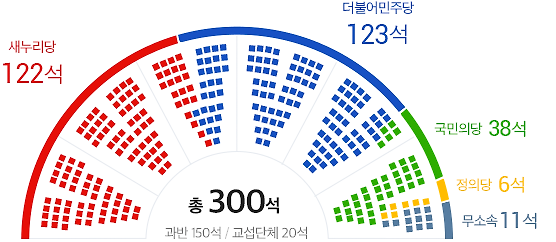Government of South Korea: The government of South Korea divides into three branches: legislative, executive, and judicial. The Constitution of the Republic of Korea determines the structure of the South Korean government.
(Image from media.daum.net)

| Group (정당) | Floor Leader | Seats (지역구) | 비례 | Total Seats (전체) |
| Saenuri Party (새누리당) | 이정현 | 105 | 17 | 122 |
| The Minju Party 더불어민주당 | 추미애 | 110 | 13 | 123 |
| The People's Party 국민의당 | 박지원 | 25 | 13 | 38 |
| Justice's Party 정의당 | 심상정 | 2 | 4 | 6 |
| Independents 무소속/기타 | 11 | 11 | ||
| 합계 | 253 | 47 | 300 |
Ministry of Foreign Affairs (외교부)
Ministry of Unification (통일부)
Ministry of the Interior (행정자치부)
Ministry of Gender Equality and Family
(여성가족부)
Ministry of National Defense (국방부)
Prosecution Service (검찰청)
Defense Acquisition Program Administration (방위사업청)
National Police Agency (경찰청)
Board of Audit and Inspection (감사원)
National Intelligence Service (국가정보원)
National Security Council (국가안전보장회의)
National Unification Advisory Council
(민주평화통일자문회의)
National Economic Advisory Council (국민경제자문회의)
Presidential Advisory Council on Science and Technology (국가과학기술자문회의)
Financial Services Commission (금융위원회)
Nuclear Safety and Security Commission
(원자력안전위원회)